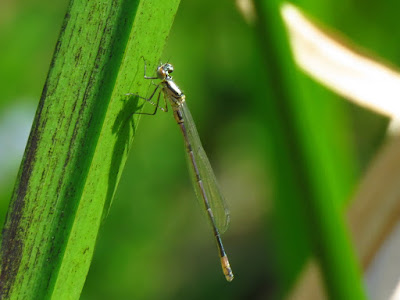Cumulative number of East Yorkshire dragonfly and damselfly species and the first record of each colonist species (data compiled from Paul Ashton's Dragonflies of South East Yorkshire, 2013).
Today I visited a pond in a site in the outskirts of the city, which has maintained water until now this year probably due to the higher than usual rainfall this winter and spring. I took advantage of a short sunny spell this afternoon in an altogether warm muggy day to try and see the Broad-bodied Chaser I had seen there before in mid May. This is a large, striking dragonfly, which readily colonises new ponds, including garden ponds. They have a flattened abdomen and dark spots on the base of the wings. Males have a powdery blue abdomen and yellow spots on the sides (top shot), the females a yellow/brown abdomen (below). Males maintain territories in ponds, where females may only approach the pond to mate and oviposit. As an adaptation to the shallow, small ponds where they develop, their larvae are able to move over damp, but otherwise dry terrain if the pools where they are developing are dry.
A female Broad-bodied Chaser (22nd May 2017, Leven Canal)
More information
Ashton, P. (2013) Dragonflies of South-east Yorkshire. 105 pp.
Hassall, C., Thompson, D. J., French, G. C. & Harvey, I. F. Historical changes in the phenology of British Odonata are related to climate. Glob. Chang. Biol. 13, 933–941 (2007).
Hickling, R., Roy, D. B., Hill, J. K. & Thomas, C. D. A northward shift of range margins in British Odonata. Glob. Chang. Biol. 11, 502–506 (2005).
Piersanti, S., Rebora, M., Salerno, G. & Gaino, E. Behaviour of the larval dragonfly Libellula depressa (Odonata Libellulidae) in drying pools. Ethol. Ecol. Evol. 19, 127–136 (2007).










